AWS Cloud Solutions for Building Enterprise-Grade Data Lakes
Key Takeaways:
- Data Lakes Are the New Oil Fields – Just like oil fueled the industrial age, data lakes on AWS fuel today’s digital enterprises with endless possibilities.
- From Traffic Jams to Fast Lanes – Say goodbye to bottlenecks of siloed data; AWS builds highways where insights move at the speed of business.
- Your Innovation Launchpad – An AWS-powered data lake isn’t just storage—it’s the rocket pad for AI, machine learning, and the next decade of data innovation.
They say data is the new oil—but just like crude oil, it’s only valuable when refined, processed, and put to use. For most enterprises today, the challenge isn’t collecting data; it’s figuring out how to unify, secure, and analyze it in ways that actually drive business outcomes. Legacy systems and siloed databases often leave organizations sitting on mountains of untapped information, unable to see the full picture of customer behavior, financial performance, or market opportunities.
This is where enterprise data lake solutions come into play. By consolidating structured and unstructured data into a single repository, companies can build a foundation for advanced analytics, AI-driven insights, and real-time decision-making. And when it comes to data lake solutions, AWS Cloud Solutions stand out as the global leader. From ETL pipelines for AWS data lakes to data lake governance and security, AWS offers a scalable, future-ready ecosystem trusted by enterprises worldwide.
At Sigma Infosolutions, we help businesses design and implement data lake on AWS strategies that go beyond just storage. Whether it’s powering digital payment solutions, enabling customer behavior analysis via AWS data lakes, or driving cost optimization for AWS data lakes, we focus on turning data into a competitive advantage. With secure data lakes on AWS, enterprises can finally break down silos and unlock growth that’s intelligent, scalable, and future-proof.
The Growing Need for Enterprise Data Lakes
Enterprises today are generating data at an unprecedented pace—from connected IoT devices and mobile apps to social interactions and millions of digital transactions processed every second. This explosion of structured, semi-structured, and unstructured data has created both opportunities and challenges. On the one hand, data has the potential to reveal game-changing insights; on the other, legacy on-premise systems often choke under the pressure.
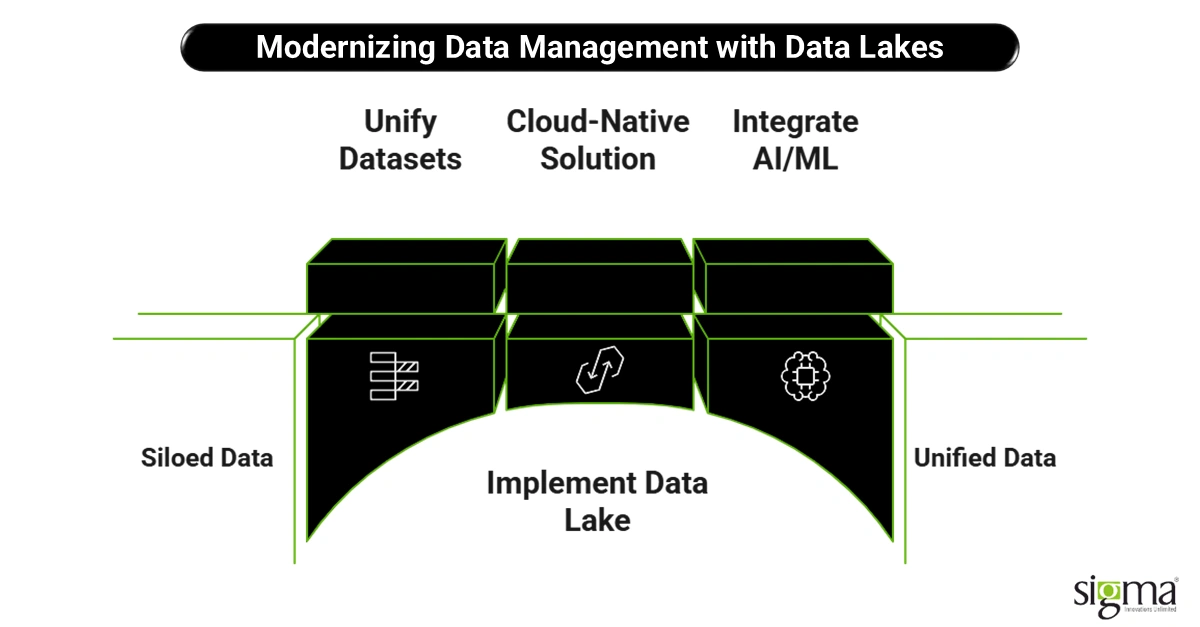
Traditional databases and warehouses were never built to handle this scale or variety. They leave organizations stuck with siloed data, costly maintenance, and limited scalability. Imagine trying to run modern digital payment solutions or real-time fraud detection with fragmented datasets—it’s like trying to predict the weather with only yesterday’s temperature reading.
That’s why forward-looking businesses are embracing enterprise data lake solutions. Unlike rigid warehouses, cloud-native data lake solutions unify massive, diverse datasets into a single, scalable environment. More importantly, they integrate seamlessly with AI, ML, and advanced analytics—unlocking smarter decisions at speed.
Industry research backs this shift. The market for cloud-based data management services is projected to grow from $40.2 billion in 2023 to $141.7 billion by 2028, a significant increase driven by a 28.7% CAGR. AWS continues to dominate the space, holding over one-third of the global cloud infrastructure market (IDC), making it the go-to choice for building data lake on AWS strategies.
With this shift, enterprises aren’t just storing data—they’re setting the stage for innovation, efficiency, and competitive advantage.
Why AWS for Enterprise-Grade Data Lakes?
When it comes to building enterprise-grade data lake solutions, few platforms can match the depth and maturity of AWS Cloud Solutions. AWS has become the gold standard for organizations that want scalable, secure, and future-ready data lakes—whether they’re managing terabytes or petabytes of information.
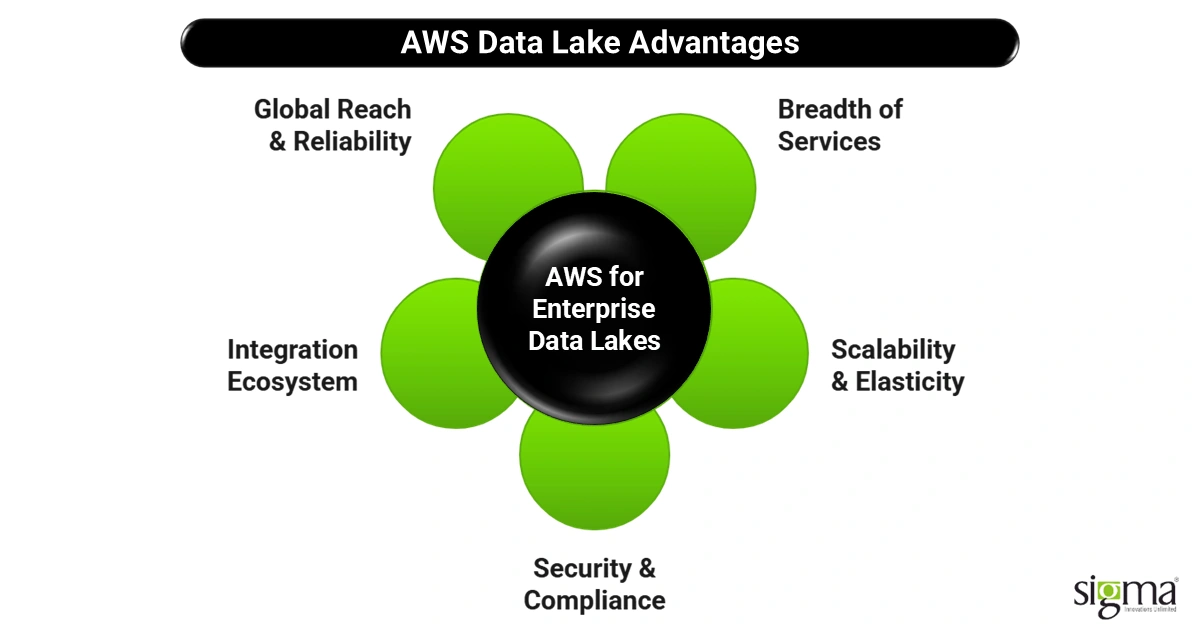
- Breadth of Services: AWS doesn’t just offer storage; it provides a full stack of services purpose-built for data lakes. Amazon S3 serves as the highly durable backbone for storing data of any type. AWS Glue automates ETL pipelines, while Lake Formation simplifies setup and security. With Athena for serverless queries, Redshift for data warehousing, EMR for big data processing, QuickSight for visualization, and SageMaker for advanced AI/ML workloads, AWS covers the entire lifecycle of data management and analytics.
- Scalability & Elasticity: One of the biggest advantages of a data lake on AWS is elasticity. Businesses can scale up to process petabytes of data—or scale down to save costs—without ever worrying about physical infrastructure. For enterprises running digital payment solutions or real-time risk modeling, this agility can be a game-changer.
- Security & Compliance: With IAM for fine-grained access control, KMS encryption, and audit-ready compliance certifications, AWS is built to handle sensitive enterprise workloads. From financial services to healthcare, companies can trust secure data lakes with AWS to meet the strictest regulatory standards.
- Integration Ecosystem: AWS data lakes play well with the tools enterprises already rely on. Whether it’s BI platforms like Tableau or Power BI, integration with ERP or CRM systems, or powering AI/ML pipelines, AWS offers unmatched interoperability.
- Global Reach & Reliability: Finally, AWS’s global infrastructure ensures uptime, performance, and disaster recovery across regions. Enterprises looking for enterprise data lakes on AWS know they’re building on a platform with proven reliability.
In short, AWS delivers the scale, flexibility, and security enterprises need to transform data from raw material into strategic advantage.
Also Read: Why the C-Suite Can’t Ignore Microservices-Based App Development Services
Core Building Blocks of a Data Lake on AWS
A modern data lake on AWS isn’t a single product—it’s an ecosystem of services that work together to transform raw data into enterprise intelligence. Let’s break it down layer by layer.
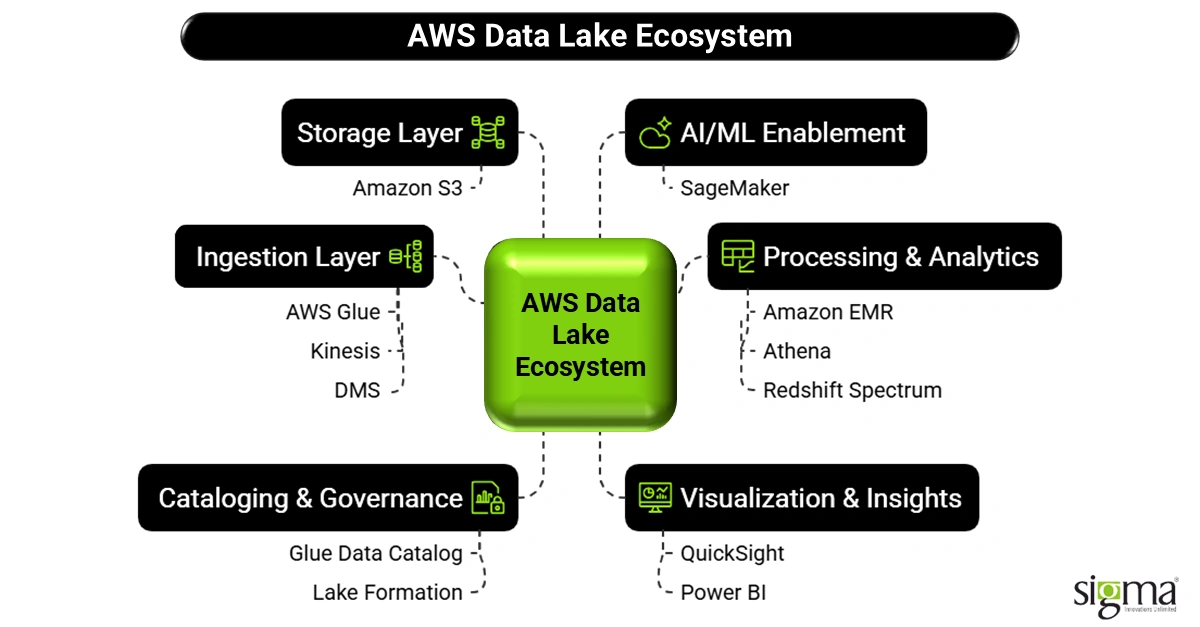
1. Storage Layer: Amazon S3 as the Foundation
At the heart of every AWS data lake is Amazon S3, a highly durable and cost-effective storage layer. It can handle structured data (like transactions) and unstructured data (like videos or IoT logs) all in one place. For example, digital payment providers often store massive volumes of transaction logs and clickstream data in S3, creating the foundation for fraud detection and customer behavior analysis.
2. Ingestion Layer: Glue, Kinesis, and DMS
Getting data into the lake is just as critical. AWS Glue automates ETL pipelines, Kinesis streams real-time IoT and app data, and Database Migration Service (DMS) brings in data from legacy or SaaS systems. A fintech using data lake solutions can ingest real-time credit card swipes through Kinesis while batch-loading regulatory compliance data via DMS.
3. Cataloging & Governance: Glue Data Catalog + Lake Formation
Once data is in the lake, it needs to be searchable and secure. AWS Glue Data Catalog provides a unified metadata store, while Lake Formation handles permissions and data lake governance and security. For industries like healthcare and finance, this ensures compliance without slowing innovation.
4. Processing & Analytics: EMR, Athena, Redshift Spectrum
Processing massive datasets becomes seamless with Amazon EMR (big data frameworks), Athena (serverless SQL queries), and Redshift Spectrum (running queries directly on S3). For instance, eCommerce companies can run ad-hoc customer segmentation analysis on petabytes of sales data—without moving it around.
5. Visualization & Insights: QuickSight + Power BI
Raw insights mean little without visualization. AWS integrates with QuickSight for fast dashboards and Power BI for enterprises already invested in Microsoft ecosystems. Retailers, for example, use these dashboards to track customer behavior analysis via AWS data lakes in near real-time.
6. AI/ML Enablement: SageMaker on Top of the Lake
The real magic happens when AI meets data lakes. Amazon SageMaker enables enterprises to build, train, and deploy predictive models directly from the data lake. A bank might use SageMaker to predict loan defaults, while a payment processor could model fraudulent transaction patterns in real time.
Together, these building blocks make AWS the ultimate platform for enterprise data lake solutions—scalable, secure, and innovation-ready.
Design Patterns & Best Practices for Enterprise Data Lakes
Building a data lake on AWS isn’t just about deploying services—it’s about designing it right from the start. Enterprises that succeed follow proven patterns and best practices to ensure their lakes remain scalable, secure, and cost-effective over the long run.
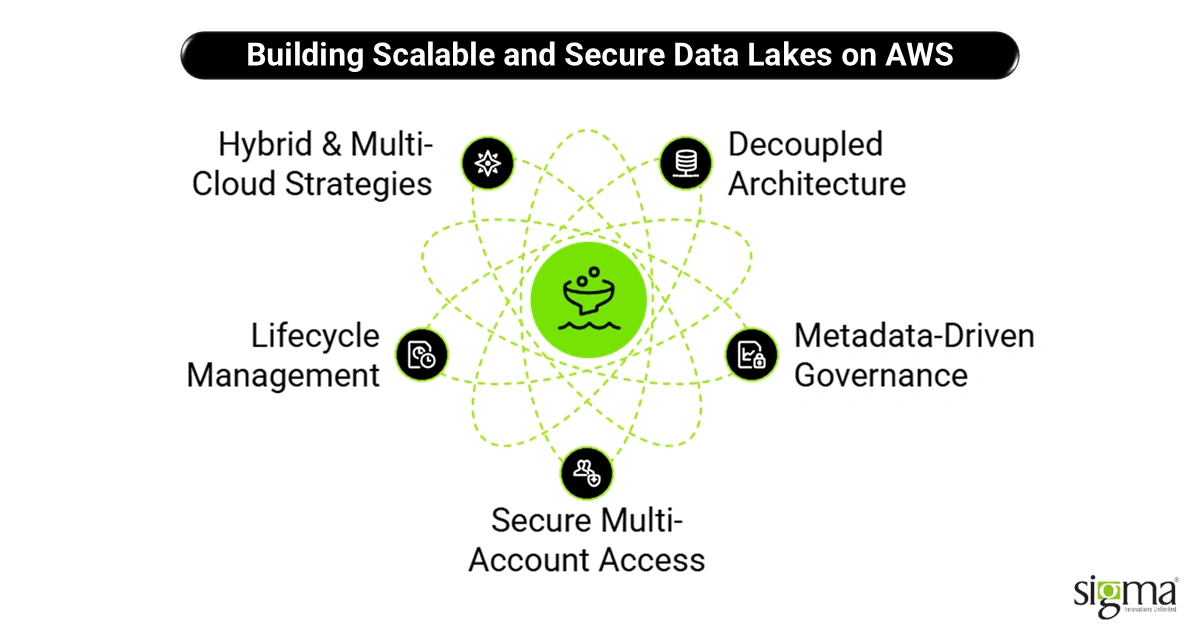
- Decoupled Architecture for Scalability: One key design principle is decoupling storage, compute, and analytics layers. With Amazon S3 as the storage backbone, processing engines like EMR or Athena can scale independently, allowing enterprises to handle everything from small ad-hoc queries to petabyte-scale batch jobs without breaking a sweat.
- Metadata-Driven Governance: Metadata acts as the GPS for your data lake. By leveraging AWS Glue Data Catalog and Lake Formation, organizations can establish metadata-driven governance that ensures discoverability, access control, and compliance. This is especially critical for regulated industries like finance or healthcare.
- Secure Multi-Account Access: Enterprises often operate in multi-team, multi-department setups. With Lake Formation and IAM policies, businesses can implement secure, fine-grained access across multiple AWS accounts—ensuring that analysts, data scientists, and executives all see only what they’re authorized to see.
- Lifecycle Management for Cost Optimization: Not all data has the same value over time. Using S3 storage classes (e.g., S3 Intelligent-Tiering or Glacier), organizations can automatically transition older data to lower-cost tiers—achieving significant cost optimization for AWS data lakes without sacrificing accessibility.
- Hybrid & Multi-Cloud Strategies: While AWS leads the market, some enterprises adopt hybrid or multi-cloud strategies. AWS integrates with on-prem systems and third-party clouds, enabling a future-proof design without vendor lock-in.
By following these patterns, enterprises build secure data lakes with AWS that scale efficiently, remain compliant, and deliver lasting business value.
Key Challenges in Building Enterprise Data Lakes
While enterprise data lake solutions on AWS promise scale and flexibility, building them isn’t without hurdles. Many enterprises run into similar challenges when moving from traditional systems to cloud-native data lake solutions.
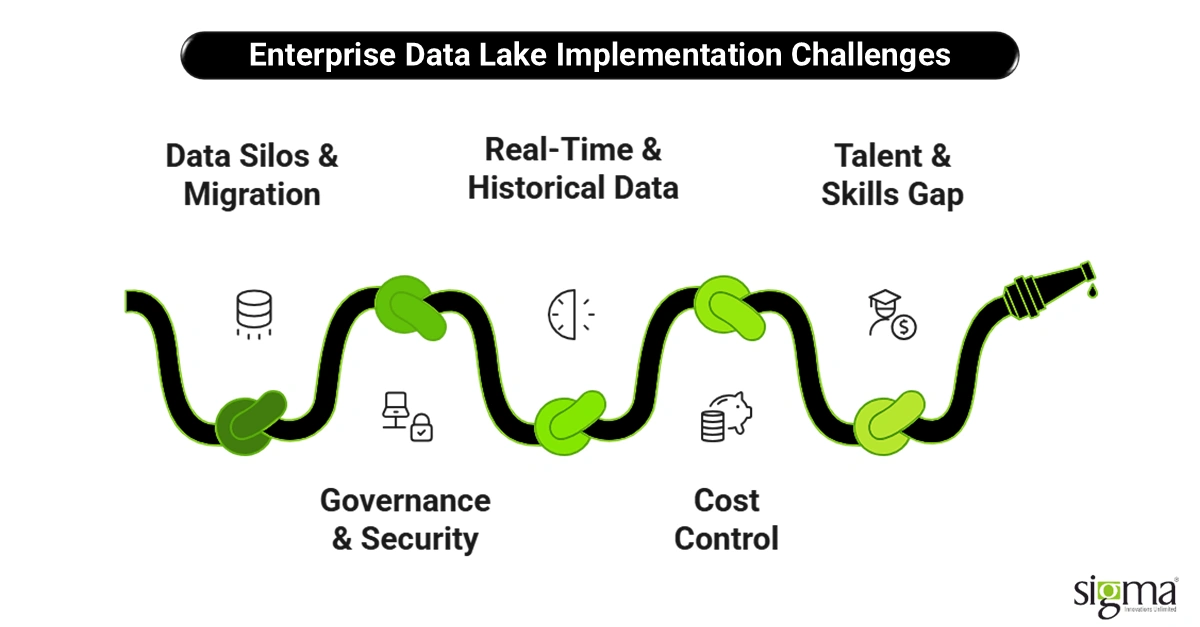
- Data Silos & Migration Complexity: Legacy systems often hold decades of siloed data, scattered across on-prem databases, SaaS apps, and ERP/CRM platforms. Migrating this into a unified data lake on AWS requires careful planning, ETL pipelines, and governance structures. Without it, enterprises risk building yet another fragmented system.
- Governance & Security at Scale: As datasets grow to petabytes, enforcing data lake governance and security becomes increasingly complex. Configuring Lake Formation, IAM policies, and encryption (KMS) requires deep expertise, especially for organizations in regulated industries like financial services.
- Balancing Real-Time & Historical Data: Enterprises need both real-time insights (like fraud detection in digital payment solutions) and long-term analytics (such as customer behavior trends). Designing an architecture that supports both without driving up costs or latency can be tricky.
- Cost Control: While AWS offers flexible pricing, uncontrolled data growth can inflate costs. Without lifecycle management and cost optimization for AWS data lakes, companies risk spending more on storage and compute than the value they generate.
- Talent & Skills Gap: Finally, many organizations underestimate the expertise required. Advanced AWS configurations—covering ingestion, cataloging, and AI/ML pipelines—demand skilled architects and engineers. This talent gap can slow adoption and limit ROI.
Recognizing these challenges upfront helps enterprises design secure data lakes with AWS that deliver sustainable, long-term impact.
Also Read: Breaking Down Enterprise App Integration Services: How It All Connects
How Sigma Infosolutions Accelerates Data Lake Success with AWS
Building an enterprise data lake on AWS requires more than just spinning up services—it demands the right strategy, skilled execution, and ongoing optimization. That’s where Sigma Infosolutions comes in. As a trusted technology partner, we help enterprises design, deploy, and scale AWS Cloud Solutions that unlock the full potential of their data.
- Consulting & Strategy: We start by assessing your current data maturity, identifying silos, and mapping business goals. From there, we define a data lake architecture on AWS that aligns with your enterprise’s growth priorities—whether that’s improving digital payment insights, powering AI-driven personalization, or streamlining compliance.
- Implementation: Our experts deploy AWS-native services like Amazon S3, Glue, Lake Formation, Athena, EMR, and Redshift, ensuring your data lake solutions are robust, scalable, and future-ready.
- Integration: Enterprises rarely operate in isolation. We connect your AWS data lake solution with ERP, CRM, eCommerce, and analytics platforms—creating a unified ecosystem where insights flow seamlessly across departments.
- AI/ML Enablement: Using Amazon SageMaker, we build predictive models directly on top of your data lake. This allows financial institutions to forecast risk, retailers to analyze customer behavior, and payment processors to spot fraudulent activity in real time.
- Governance & Security: Compliance is non-negotiable. We implement IAM, encryption (KMS), and data lake governance and security best practices to ensure sensitive data remains protected and audit-ready.
- Managed Services: Beyond implementation, we provide ongoing monitoring, performance tuning, and cost optimization for AWS data lakes—so your teams can focus on driving business outcomes, not managing infrastructure.
Industry Use Cases & Success Stories
The true power of a data lake on AWS shines when it’s applied to real-world challenges across industries. From retail to healthcare, enterprises are leveraging AWS Cloud Solutions to unlock growth and resilience.
Retail & eCommerce
Imagine having a full Customer 360 view—every purchase, website visit, and support interaction consolidated into one place. Retailers use enterprise data lake solutions on AWS to build recommendation engines that personalize shopping, optimize inventory in real time, and forecast demand with uncanny accuracy.
Fintech
In financial services, the stakes are high. With data lake solutions, fintechs and banks can analyze millions of transactions per second for anomalies. Real-time fraud detection, AI-driven credit scoring, and risk analytics become possible when streams of payment data are unified and processed at scale. For companies delivering digital payment solutions, secure, scalable AWS data lakes are nothing short of mission-critical.
Explore how Sigma’s AWS Cloud Solutions helped a leading mortgage provider to modernize its Point-of-Sale (POS) system using AWS and Next.js to drive outcome leading to:
- 60% faster pre-qualification decisions
- 80% automation of Identity/Income verification
- 60% increase in Loan Completion rate
Healthcare
Patient data is notoriously fragmented across providers, labs, and insurance platforms. With a secure data lake with AWS, healthcare organizations unify records, apply compliance-driven analytics, and improve patient outcomes—all while meeting HIPAA and regulatory mandates.
Manufacturing
From assembly lines to connected devices, manufacturers rely on IoT data streams. By processing sensor data through AWS Glue, EMR, and SageMaker, enterprises can predict equipment failures before they happen, reducing downtime and improving efficiency.
Across these industries, the common theme is clear: enterprise data lakes on AWS transform data chaos into business clarity. The result? Smarter decisions, faster innovation, and a competitive edge that’s hard to replicate.
The Future of Data Lakes with AWS
The next decade will redefine how enterprises use data, and AWS Cloud Solutions are already shaping that future. We’re moving from traditional analytics to serverless, AI-driven data lakes that scale on demand and eliminate the overhead of infrastructure management. With services like Athena, Glue, and EMR evolving rapidly, companies can focus less on provisioning and more on insights.
A major shift on the horizon is the integration of Generative AI. Imagine pairing secure data lakes with AWS and Retrieval-Augmented Generation (RAG) models—enterprises could instantly surface insights from years of historical data while maintaining governance and compliance. This opens doors to advanced customer support, intelligent product design, and predictive financial modeling.
At the same time, enterprises are exploring multi-cloud and edge computing strategies. Data generated at the edge—whether from IoT devices, retail stores, or digital payments—will flow seamlessly into enterprise data lake solutions on AWS, ensuring faster decision-making closer to where data is created.
Finally, data lakes on AWS are evolving into the backbone for data mesh and data fabric architectures, enabling decentralized ownership of data while maintaining enterprise-wide governance.
For businesses, the message is clear: prepare now. The enterprises that embrace these innovations early will not just manage data—they’ll turn it into a strategic engine for the next decade of data innovation.
Final Thoughts
In today’s data-driven economy, enterprises can no longer afford to postpone building cloud-native data lakes. The competitive edge lies in the ability to unify data, extract real-time insights, and innovate faster than the market. A modern data lake on AWS is no longer a “nice-to-have”—it’s the foundation for long-term scalability, resilience, and business agility.
With its unmatched ecosystem of tools and services—ranging from Amazon S3 and Glue to Athena, EMR, and Lake Formation—AWS offers the most comprehensive platform for designing and scaling enterprise-grade data lake solutions. Add in built-in security, governance, and AI/ML integration, and the case for AWS becomes undeniable.
This is where Sigma Infosolutions steps in. As a trusted AWS Cloud Solutions partner, we help enterprises harness the full power of AWS—ensuring seamless migrations, secure architectures, and data platforms ready for the future. Whether you’re modernizing legacy systems or preparing for the next decade of AI-driven analytics, Sigma brings the strategy and execution expertise you need.

